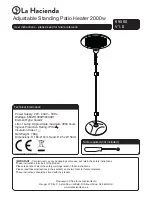
44
www. lochinvar .com
100221773_2000189439_Rev. 01
COMBUSTION CHAMBER AND BURNER CLEANING
In the event your burner or burner air openings require
cleaning, Call your service agency to remove and clean
the burner and correct the problem that required the burner
to be cleaned.
HOUSEKEEPING
•
Do not obstruct combustion air
openings at the rear of the water
heater.
•
Do not use or store flammable
vapor products such as gaso-
line, solvents or adhesives in the
same room or area near water
heater or other appliance.
•
Can cause serious injury or
death.
Fire and Explosion Hazard
DANGER
INSTALLED IN SUITABLE AREA:
To ensure sufficient ventilation and combustion air
supply, proper clearances from the water heater must
be maintained. See “Locating The New Water Heater”
section. Combustible materials such as clothing, cleaning
materials, or flammable liquids, etc. must not be placed
against or adjacent to the water heater which can cause
a fire.
ANODE ROD MAINTENANCE
• Avoid water heater damage.
• Inspection and replacement of anode rod required.
Property Damage Hazard
CAUTION
Anode Rod.
The anode rod is a sacrificial metal rod that
helps avoid corrosion and premature failure (leaks) in the
tank. The anode rod is a consumable item. Inspect the
anode rod after the first six months of operation when
you drain and flush the tank. Replace the anode rod if
it is substantially worn out or depleted (see Figure 51).
Thereafter, inspect the anode rod annually or more
frequently if needed. If you use a water softener, your
anode rod will deplete faster than normal. Inspect the
anode rod more frequently, replacing the anode rod if it
is depleted. Once the anode rod is depleted, the tank will
start to corrode, eventually developing a leak. Obtain a
new anode rod from your local plumbing supplier or have a
qualified person replace it. (Anode rods are a consumable
item and are not covered under warranty).
Certain water conditions will cause a reaction between the
anode rod and the water. The most common complaint
associated with the anode rod is a “rotten egg smell”
produced from the presence of hydrogen sulfide gas
dissolved in the water. The removal of the anode rod
requires a 1-1/16” socket.
Important:
Do not operate the water heater without a
functioning anode rod as this will void any warranties.
A special anode rod may be available if water odor or
discoloration occurs.
Note:
This rod may reduce but not eliminate water odor
problems. The water supply system may require special
filtration equipment from a water conditioning company to
successfully eliminate all water odor problems.
To replace the anode:
1. Turn “OFF” the electrical supply to the water heater.
2. Turn “OFF” the gas supply at the Main Gas shut-off
Valve.
3. CLOSE the cold-water inlet valve to the water heater.
4. OPEN a nearby hot-water faucet and leave open to
allow for draining.
5. Drain approximately 5 gallons of water from tank. (Refer
to “Draining And Flushing” for proper procedures).
Close drain valve.
6. Remove old anode rod.
7. Use Teflon
®
tape or approved pipe sealant on threads
and install new anode rod.
8. Remove the hose and follow instructions in the
“Filling The Water Heater” section.
9. Follow the lighting instructions on the label or see
“Lighting Instructions” to restart the water heater.
See the Figure 52 for anode rod location.
NEW
PARTIALLY DEPLETED
FULLY DEPLETED
Figure 51.













































